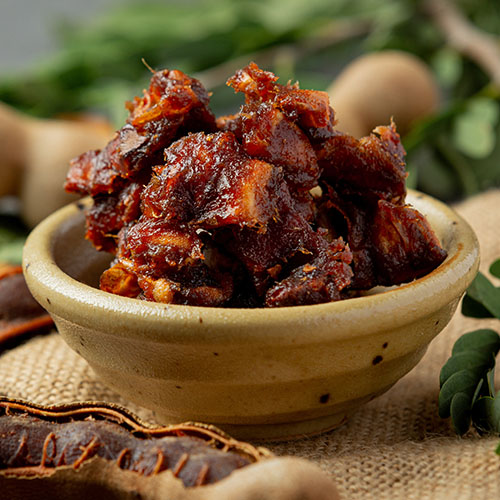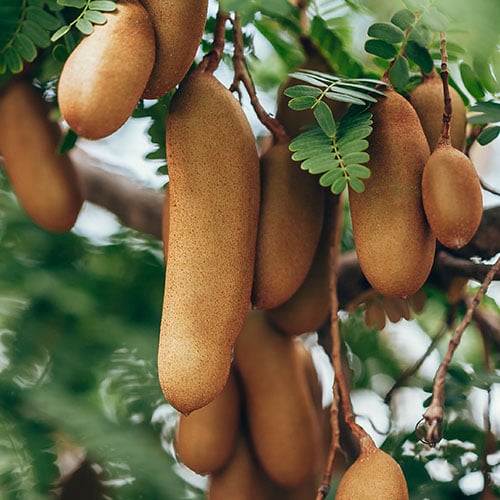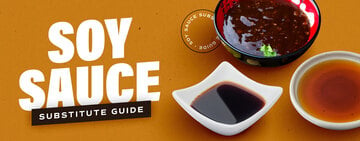What Is Tamarind?
Last updated on May 19, 2025Kevin SinghelKnown for its unique sweet-sour flavor that enhances sauces, beverages, and savory dishes, tamarind is a versatile tropical fruit widely used in global cuisines. A staple in Asian, Latin American, and African cooking, tamarind brings depth to dishes like pad Thai and chutneys. Understanding its taste, culinary uses, and health benefits unlocks new menu possibilities, appealing to adventurous diners seeking bold, authentic flavors. Below we explore tamarind’s origins and innovative ways to incorporate it into dishes, offering a valuable ingredient to elevate your offerings.
Shop All Fresh TamarindWhat Does Tamarind Taste Like?

Tamarind is a flavor powerhouse, offering a complex balance of sweet, sour, and slightly tangy notes that can elevate both savory and sweet dishes. Its unique taste profile makes it a sought-after ingredient in global cuisines, from tangy pad Thai sauces to refreshing agua frescas. Understanding tamarind’s flavor is key to incorporating it effectively into menus, whether as a marinade, a beverage base, or a finishing touch for depth and acidity.
Is Tamarind Sour?
Tamarind is naturally sour, with a tartness similar to citrus or vinegar, making it a popular acidulant in dishes like soups, chutneys, and dipping sauces. Its high tartaric acid content gives it a sharp flavor that cuts through rich or fatty foods, making it ideal for balancing dishes in commercial kitchens.
Is Tamarind Spicy?
Tamarind itself is not spicy, it’s primarily sweet and sour. However, it’s often paired with spices like chili, cumin, and ginger in sauces, marinades, and beverages, creating a dynamic flavor contrast that enhances heat without overpowering it. This makes it a great base for spicy glazes or hot sauces in foodservice applications.
Is Tamarind Sweet?
While tamarind has a natural sweetness, especially when ripe, its dominant flavor is sour with a subtle molasses-like undertone. In commercial settings, sugar or honey is often added to tamarind pastes or concentrates to mellow its tartness, making it perfect for desserts, candies, or sweet-and-sour dressings.
How to Use Tamarind

Tamarind’s bold, tangy-sweet flavor can transform dishes, but knowing how to work with its different forms ensures consistency and efficiency in foodservice operations. Whether preparing sauces, marinades, or beverages, choosing the right tamarind product can streamline prep and enhance flavor delivery.
- Raw Tamarind: Sold in whole pods with a hard shell, raw tamarind requires peeling and deseeding before use. Its pulp offers a fresh, intense sourness ideal for housemade pastes, syrups, or direct use in beverages.
- Tamarind Paste: Ready to use and smooth in texture, tamarind paste blends seamlessly into dressings, soups, and glazes. Its convenience makes it a time-saving choice for high-volume kitchens.
- Tamarind Blocks: Compressed blocks of pulp and seeds need soaking and straining but deliver a pure, unadulterated tamarind flavor. Perfect for traditional recipes where authenticity is key, such as pad Thai or tamarind-based curries.
- Tamarind Concentrate: A highly reduced, potent liquid, tamarind concentrate packs a punch in small doses. Its long shelf life and instant solubility make it ideal for cocktails or last-minute recipe adjustments.
Tamarind Origin
Tamarind traces its origins to tropical Africa, where it grew wild in Sudan and surrounding regions before spreading across continents through ancient trade routes. Soon it reached India, where it became deeply ingrained in regional cuisines. Arab merchants later introduced tamarind to the Middle East, while European colonizers and explorers facilitated its spread to Latin America and the Caribbean during the 16th century. Today, India remains the largest producer, though Thailand, Mexico, and other tropical regions also cultivate it extensively.
Understanding tamarind’s origins helps explain its versatility in global dishes, from Indian chutneys and Thai soups to Mexican candies and Caribbean beverages. Its long-standing culinary significance makes it more than just an ingredient, offering chefs an authentic way to connect with diverse flavor traditions.
Tamarind Substitutes

While tamarind’s unique sweet-sour profile is hard to replicate perfectly, several ingredients can approximate its flavor when tamarind is unavailable. When needing quick solutions, these substitutes help maintain dish integrity without compromising taste.
- Lime Juice and Brown Sugar: A blend of lime juice and brown sugar mimics tamarind’s tangy-sweet balance. Use a 2:1 ratio (lime to sugar) in marinades, dressings, or dipping sauces for a bright, caramelized acidity.
- Pomegranate Molasses: With its deep tartness and subtle sweetness, pomegranate molasses works well in Middle Eastern-inspired dishes. Substitute 1:1 in glazes or soups, though it’s slightly fruitier than tamarind.
- White Vinegar and Date Paste: Combine vinegar’s sharpness with date paste’s richness for a fermented-like tang. Ideal for chutneys or braised dishes, adjust ratios based on desired sweetness.
- Mango Powder (Amchoor): Dried mango powder delivers a fruity sourness, perfect for sprinkling into curries or dry rubs. Use sparingly, as it lacks tamarind’s sweetness.
- Worcestershire Sauce: Already containing tamarind, this condiment adds umami depth to stocks or mixes. Reduce salt elsewhere in the recipe to compensate for its savory notes.
Tamarind FAQ
Below we answer some of the most common questions regarding tamarind:
How Long Is Tamarind Good For?
Proper storage is key to maximizing tamarind's shelf life in commercial kitchens. Whole tamarind pods last up to 2 years when kept in a cool, dry place, while compressed blocks retain quality for about 6-12 months unopened. Once opened or prepared as paste, refrigerated tamarind stays fresh for 2-3 months, and tamarind concentrate can last up to a year due to its reduced moisture content. Labeling containers with preparation dates and storing tamarind products in airtight packaging can help maintain optimal flavor and prevent waste.
Does Tamarind Have Gluten?

Pure tamarind in its natural form is gluten-free, making it a safe ingredient for gluten-sensitive diners. However, foodservice operators should exercise caution with processed tamarind products like sauces or concentrates, as these may contain additives or thickeners that introduce gluten.
Verify labels for gluten-free certification when purchasing commercial tamarind products, especially pre-mixed sauces or seasoning blends. By sourcing carefully and communicating ingredient transparency, kitchens can confidently incorporate tamarind into gluten-free menu offerings without compromising flavor or safety.
Is Tamarind a Legume?
Botanically speaking, tamarind is indeed a legume. It grows in pods as the fruit of the Tamarindus indica tree, which belongs to the Fabaceae (legume) family. However, unlike most edible legumes where the seeds are eaten, such as lentils or chickpeas, the primary use of tamarind is the sticky pulp surrounding the seeds.
This distinction is important because while tamarind shares lineage with legumes, its culinary applications and allergen profile differ significantly from common legumes. Foodservice operators should note that tamarind doesn't contain the same proteins that trigger peanut or soybean allergies, making it generally safe for most diners with legume sensitivities when served in its pure form.
What Are Tamarind Pods?
Tamarind pods are the natural fruit of the tamarind tree, featuring hard, brown shells that protect the sticky, fibrous pulp inside. Each pod typically contains 4-12 seeds surrounded by the tart-sweet flesh that's used in recipes from sauces to beverages.
For professional kitchens, whole pods offer the most authentic tamarind flavor but require extra prep, as the brittle shells must be cracked open and the pulp separated from seeds and fibers before use. While less convenient than processed pastes or concentrates, working with whole pods allows chefs to control texture and intensity in traditional recipes like tamarind-based soups or candies.
Can You Eat Tamarind Raw?
Tamarind can be eaten raw straight from the pod, offering an intense sweet-sour flavor that varies depending on ripeness. Underripe tamarind tends to be extremely tart, while ripe pods develop a more balanced, fruity sweetness. Raw tamarind pulp can be used to make fresh beverages, chutneys, or dessert toppings, though its sticky texture and seeds require straining for smooth consistency. Many commercial kitchens opt for prepared pastes or concentrates for efficiency, but using raw tamarind allows for greater control over flavor profiles in signature dishes.
From its complex flavor profile to its global culinary versatility, tamarind offers foodservice operators a dynamic ingredient to differentiate their menus. Whether incorporated as a tangy glaze, a refreshing drink base, or an unexpected dessert accent, this tropical fruit bridges sweet and savory applications with ease. Understanding its various forms, from whole pods to convenient concentrates, empowers chefs to balance authenticity with kitchen efficiency. As consumer demand for bold, international flavors continues to trend, tamarind presents an opportunity to craft memorable dishes that stand out in a competitive market.








